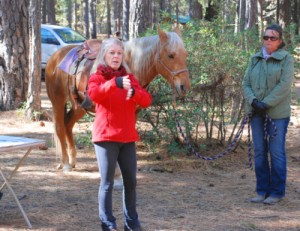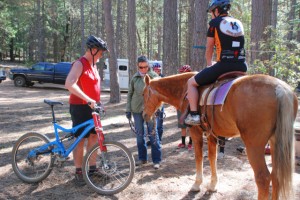On a stunning autumn day in October, the Friends of Boggs Mountain (FOBM), the Lake-Mendo Unit of the Back Country Horsemen of California (BCHC), Main Street Bicycles, and the Clear Lake and Kelseyville High School Bike Team came together to hold the “Wag, Walk and Wride” trail etiquette event at Boggs Mountain Demonstration State Forest.

BCHC President, Paul Villanueva, kicked off the program with a brief description of the Back Country Horsemen’s mission and goals. Paul explained their core mission is to preserve and protect existing trails, support multiuse where it already exists, and help foster goodwill among all trail users in Lake and Mendocino Counties. The BCHC also provides a valuable service for government agencies such as the Mendocino National Forest that avail of horse and pack stock to haul equipment in and out of the backcountry where motorized vehicle access is not possible.
In addition, the BCHC strives to educate trail users on proper trail etiquette to minimize user conflict. For instance, Paul recommended stepping off the trail on the downhill side to let equestrians pass as horses may consider someone or something above them a predator. Another helpful tip was to calmly talk to the horse and rider as you approach to help assure the animal that you are not a threat.
On some occasions, people will step aside and wind up behind a brush or tree thinking they can avoid disturbing a horse altogether.
“What might be considered courteous could actually result in agitating a horse on a trail,” Paul warned.
As prey animals, horses are always on the lookout for predators, and something unseen that makes a movement or noise near the trail can spook them. Paul emphasized that because hikers and mountain bikers need to yield to horseback riders, it’s often best for the equestrian to communicate with other trail users and guide them in a way that keeps their horse calm. In addition, it is recommended that young or green horses are slowly introduced to multiuse trails, and even experienced horses should be desensitized to many different objects and animals. Paul enjoys seeing his grandkids have fun riding their bikes around his horses, as it’s a great way to get them used to bikes on trails.

Sarah Reid, State Trails Chair of the California State Horseman’s Association, was next to speak, and gave a broad picture of the California trail system. She also discussed steps taken at Annadel State Park in Santa Rosa to avoid conflict in a region that sees considerably more trail traffic than Boggs. As a member of the Mounted Assistance Patrol, Sarah and other volunteers serve as “trail ambassadors” ready to lend assistance or to provide gentle reminders on trail etiquette to park visitors.
Sarah also demonstrated some ways to read the body language of a horse. Lake County Horse Council president, Virginia Vovchuk, led her lovely Morgan horse, Shalako, toward center stage. Pointing out Shalako’s lowered head, the cocked position of her hind leg, ears slightly to the side are generally signs of a relaxed horse, Sarah explained to the captivated audience.

To illustrate a horse’s startle response, Sarah rustled the BCHC banner behind her, and Shalako suddenly raised her head, her ears spun toward the sound, and her muscles stiffened. “Buckin’ Benny”, Paul’s trusty pack mule that appeared to be dozing nearby, also gave a start. This demonstration was a reminder that equestrians have a responsibility to be able control a half-ton animal as best as they can, as well as for other users to be mindful of how they might elicit this response when approaching horses from around blind corners or from behind.
The Clear Lake and Kelseyville High School Bike Team were next on the program. With the help of four members of their team, Coach Tami Cramer briefly covered the history of the co-ed team and their plans for the future, which included growing the team through “interest rides” at Boggs this Fall.
To assuage trail user concerns about the training they do at Boggs in the winter and spring, co-coach Jeff Cramer emphasized that team members concentrate on technical riding, not speed. The young cyclists then explained the policy they strive to observe in interacting with other trail users, consistent with the trail courtesies discussed in the earlier part of the program.
Jeff went on to describe the arduous physical training mountain biking requires and how the experience helps to shape the kids’ attitude toward exercise and the outdoors, as well as instilling confidence.

One of the highlights of the day came as bike team members took turns riding on a different kind of saddle – courtesy of Shalako. Virginia helped them get a feel for what it’s like to be 8 feet off the ground, and to put themselves on a mount that requires a different kind of skill and knowledge.
Every boy grinned from ear to ear, enjoying the higher elevation, but confessed some apprehension of “not quite being in control”. Hopefully, this realization gave them a more empathic understanding of the horsemanship skills required to handle a horse, especially on a multiuse trail where all sorts of things can unexpectedly come at or behind you.
Finally, Paul and another BCHC member, Debbie Watson from Willits, took back the reins of the program and gave a terrific hands-on demonstration on how to pack a horse or mule for an extended backcountry trip. They described the use of “panniers” – larger versions of road bike luggage – how to securely strap them on a pack saddle, the necessity of balancing the weight, and “smart packing”. Since Paul often spends weeks in the backcountry, the ability to carry everything you anticipate along with a few macgyveresque skills and tools is critical.
The Cramers, who also own Main St. Bicycles, got Specialized Bicycles to provide free water bottle giveaways stuffed with Halloween treats and Clif Bars. After refreshments, several participants took off for a “wag, walk and wride” to enjoy the rest of the Indian summer day.
“I went to an event like this at Montaña De Oro State Park near San Luis Obispo earlier this year,” explained Gigi Stahl, event organizer and FOBM volunteer, “and admired the camaraderie and trail stewardship in that group. FOBM feels that as more and more visitors come to Boggs each year, we need to develop a trail culture that is inclusive and prepared to handle heavier use in a diplomatic and informative way. Kids and adults in our local community are our trail ambassadors, and we’re grateful to Sarah Reid, other out-of-county as well as local participants who came to show their commitment to trail user education.”
“The Lake County Horse Council is a strong supporter of safe trails and education,” Vovchuk added. “It was great to share information about our horses with other trail users, and learn what we have in common.”
To keep the momentum going, the Friends of Boggs will be rolling out a trail etiquette brochure in early 2014.
